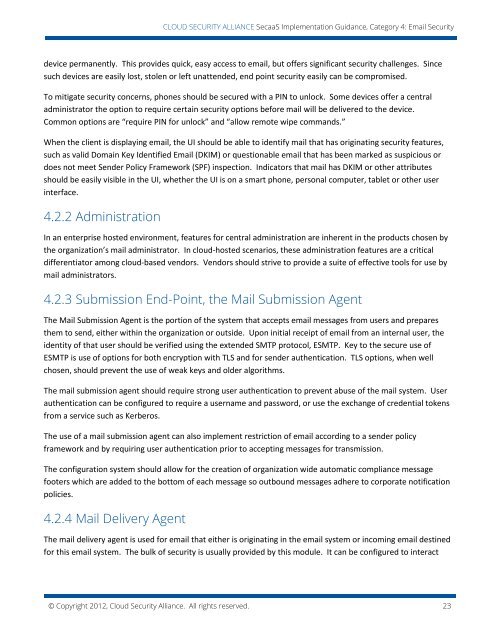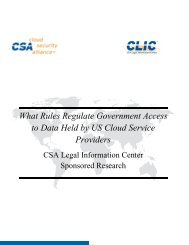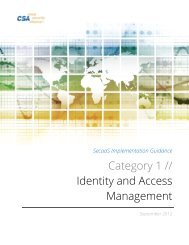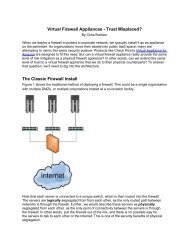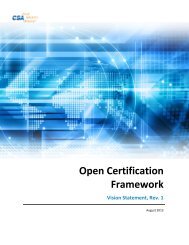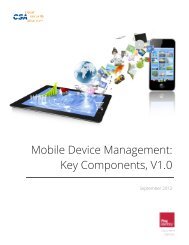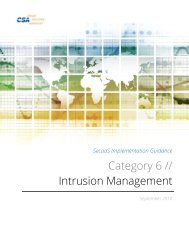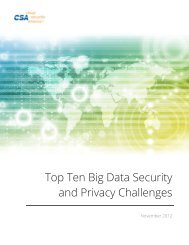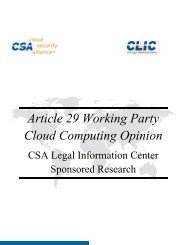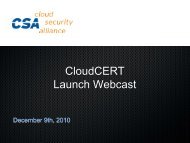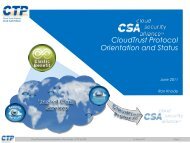Email Security Implementation Guidance - Cloud Security Alliance
Email Security Implementation Guidance - Cloud Security Alliance
Email Security Implementation Guidance - Cloud Security Alliance
- No tags were found...
You also want an ePaper? Increase the reach of your titles
YUMPU automatically turns print PDFs into web optimized ePapers that Google loves.
CLOUD SECURITY ALLIANCE SecaaS <strong>Implementation</strong> <strong>Guidance</strong>, Category 4: <strong>Email</strong> <strong>Security</strong>device permanently. This provides quick, easy access to email, but offers significant security challenges. Sincesuch devices are easily lost, stolen or left unattended, end point security easily can be compromised.To mitigate security concerns, phones should be secured with a PIN to unlock. Some devices offer a centraladministrator the option to require certain security options before mail will be delivered to the device.Common options are “require PIN for unlock” and “allow remote wipe commands.”When the client is displaying email, the UI should be able to identify mail that has originating security features,such as valid Domain Key Identified <strong>Email</strong> (DKIM) or questionable email that has been marked as suspicious ordoes not meet Sender Policy Framework (SPF) inspection. Indicators that mail has DKIM or other attributesshould be easily visible in the UI, whether the UI is on a smart phone, personal computer, tablet or other userinterface.4.2.2 AdministrationIn an enterprise hosted environment, features for central administration are inherent in the products chosen bythe organization’s mail administrator. In cloud-hosted scenarios, these administration features are a criticaldifferentiator among cloud-based vendors. Vendors should strive to provide a suite of effective tools for use bymail administrators.4.2.3 Submission End-Point, the Mail Submission AgentThe Mail Submission Agent is the portion of the system that accepts email messages from users and preparesthem to send, either within the organization or outside. Upon initial receipt of email from an internal user, theidentity of that user should be verified using the extended SMTP protocol, ESMTP. Key to the secure use ofESMTP is use of options for both encryption with TLS and for sender authentication. TLS options, when wellchosen, should prevent the use of weak keys and older algorithms.The mail submission agent should require strong user authentication to prevent abuse of the mail system. Userauthentication can be configured to require a username and password, or use the exchange of credential tokensfrom a service such as Kerberos.The use of a mail submission agent can also implement restriction of email according to a sender policyframework and by requiring user authentication prior to accepting messages for transmission.The configuration system should allow for the creation of organization wide automatic compliance messagefooters which are added to the bottom of each message so outbound messages adhere to corporate notificationpolicies.4.2.4 Mail Delivery AgentThe mail delivery agent is used for email that either is originating in the email system or incoming email destinedfor this email system. The bulk of security is usually provided by this module. It can be configured to interact© Copyright 2012, <strong>Cloud</strong> <strong>Security</strong> <strong>Alliance</strong>. All rights reserved. 23


